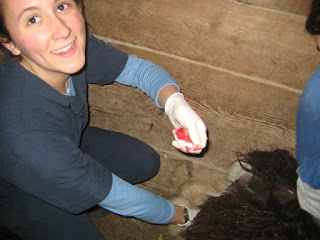Send in 20 vet students!
A few weeks ago, this email appeared in my inbox:
Seeing as how I have zero experience working with llamas, naturally, I signed up.
It turned out that most of the llamas were geldings, so we knew ahead of time that we probably weren't going to be doing any preg checks, but that was just about all we knew going into the day. When we arrived at the farm, the owner showed us around, and then explained his plan: one by one, send each llama into a squeeze chute, vaccinate it, scan it for a microchip (just like the ones to reunite lost pets with their owners), and take its photo for his website.
A low hum, similar to the sound made by a swarm of angry hornets, filled the barn: twenty vet students, who had just driven 2 and a half hours to get some hands-on llama wrangling experience, did the math, and immediately figured that 3 vaccines, a photo, and scanning for a microchip meant approximately 5 people would be occupied at any given moment, while the rest of us stood around and watched.
A few tentative hands went up, and with them, a few tactful inquiries were made.
"Dr. Smith, is there anything we can do with the llamas while they are still in the pen, before they go to the chute?"
"It seems like putting each llama through the chute might take a very long time."
"Maybe we can put the first one in the chute, just to demonstrate everything we're going to be doing."
After the first llama was secured in the chute, vaccinated, scanned, and photographed, the farm owner had a brilliant idea: "Maybe," he mused aloud, "if the students work in teams....they'll be able to do the vaccines in the pens, and we'll use the chute just for photos and microchip scanning."
So, that is what we did. There was a big open pen toward the back of the barn, and four or five smaller pens or stalls near the front. Other volunteers (local llama enthusiasts) sent groups of llamas out of the big pen, and we herded them into the stalls. Then we got to work. A pair of students started drawing up vaccines, and I joined up with some of my friends to start wrestling llamas.
It was harder than we suspected. Llamas are not huge creatures, not compared to horses and dairy cows, but they are strong. They fling their necks around, rear up, and strike with their hind legs. They are also agile--on more than one occasion, a llama, standing at the gate to a pen that was at least at their eye-level, would get the notion that life outside the pen looked a lot more promising than life inside the pen, where it's brethren were systematically being chased around, poked, and prodded. So it would do what any llama would do: take a deep breath, and attempt to jump straight up and over the gate. Many were successful; including one that jumped over the gate I was guarding to prevent just such an occurrence.
Two of the vaccines we were giving could go right into the muscle; but the third had to go subcutaneously--under the skin. The llamas' extensive fleeces, and thick, tight skin make sub-Q injections a challenge at best. Luckily, whoever designed the llama gave it a bare patch of skin, right in its armpit, just perfect for giving injections. You still have to move the fleece out of the way to find that little bare patch, and you still have to get that needle through the tough skin, but it's a heck of a lot easier than trying anywhere else.
After about two solid hours of vaccinating, we seemed to be about half way through, and took a break to eat lunch. The owner provided us with pizza, and lots of desserts, including several different kinds of brownies and cookies, and chocolate cupcakes. Someone must have informed him that vet students will do just about any task if there's a free meal involved. After lunch, everyone was re-energized, and the second half of the llamas were vaccinated in what seemed like half the time it took to do the first half. Then, the real fun began!
Although the llamas were supposed to have all been females or geldings, we ended up with six that were intact males. (Did I mention that one of our tasks was to cop a feel of every llama we vaccinated to determine that exact fact?) Six times two is twelve; twelve students would have the chance to perform half of the castration procedure. After watching the first one, and calculating the odds that they would actually get to do the procedure, and realizing what time it would be when they arrived back at school, a couple of carloads of students left, vastly increasing the chance that I, myself, would get to castrate a llama. Once Dr. Sprout had guided students through the first 2 llamas, she said, "You guys get the drill now, right? Can you take it from here?" And we did. Those who had already gone coached the ones who hadn't, and those who were waiting held tails out of the way, sat on unruly llamas, passed instruments, or documented each other's achievement of another vet school milestone: First Surgury on a Llama. First Surgury Without a Clinician Watching. First Surgury in the Field. For most of us, First Surgury would suffice.
Tuesday, February 22, 2011
Subscribe to:
Post Comments (Atom)



No comments:
Post a Comment